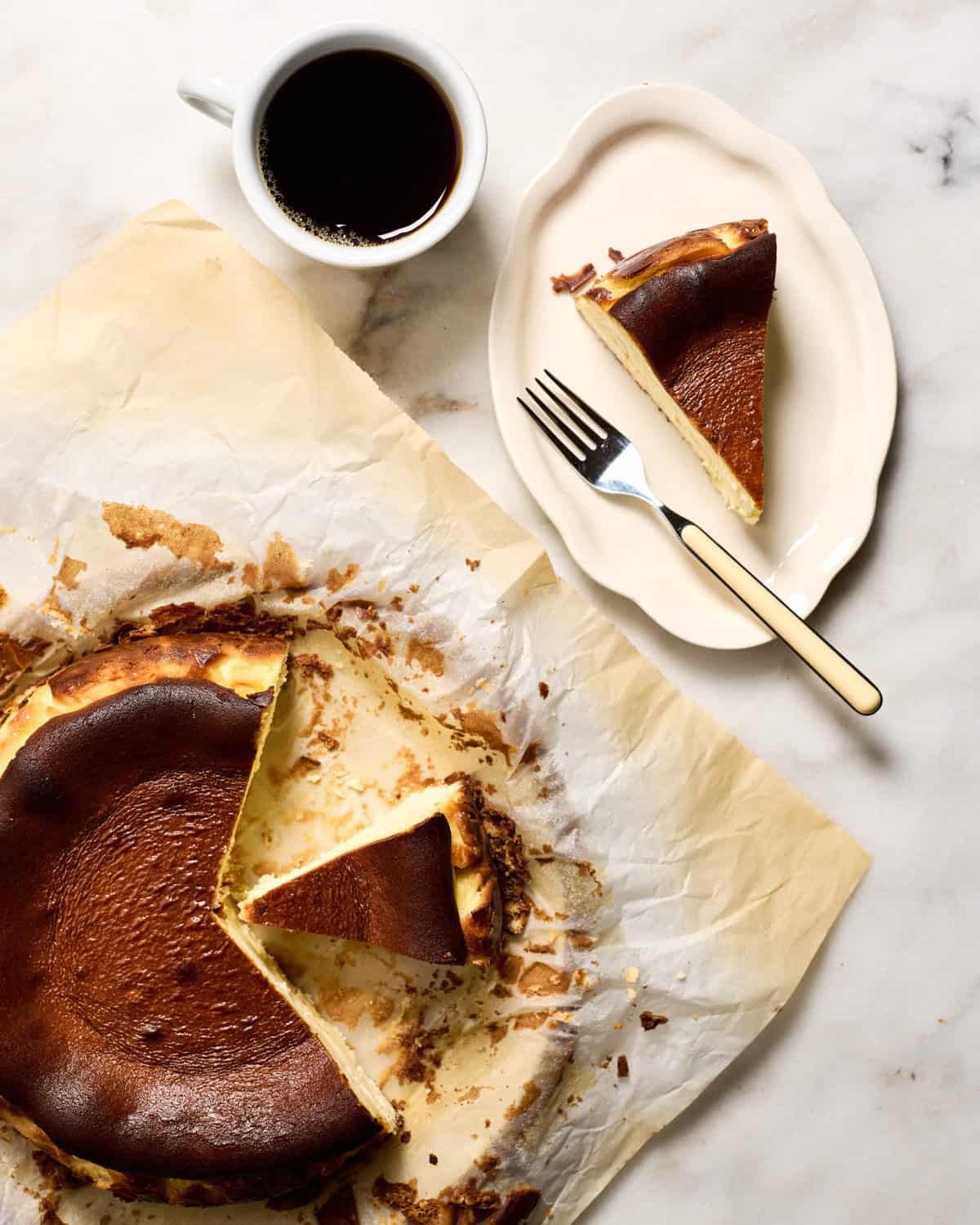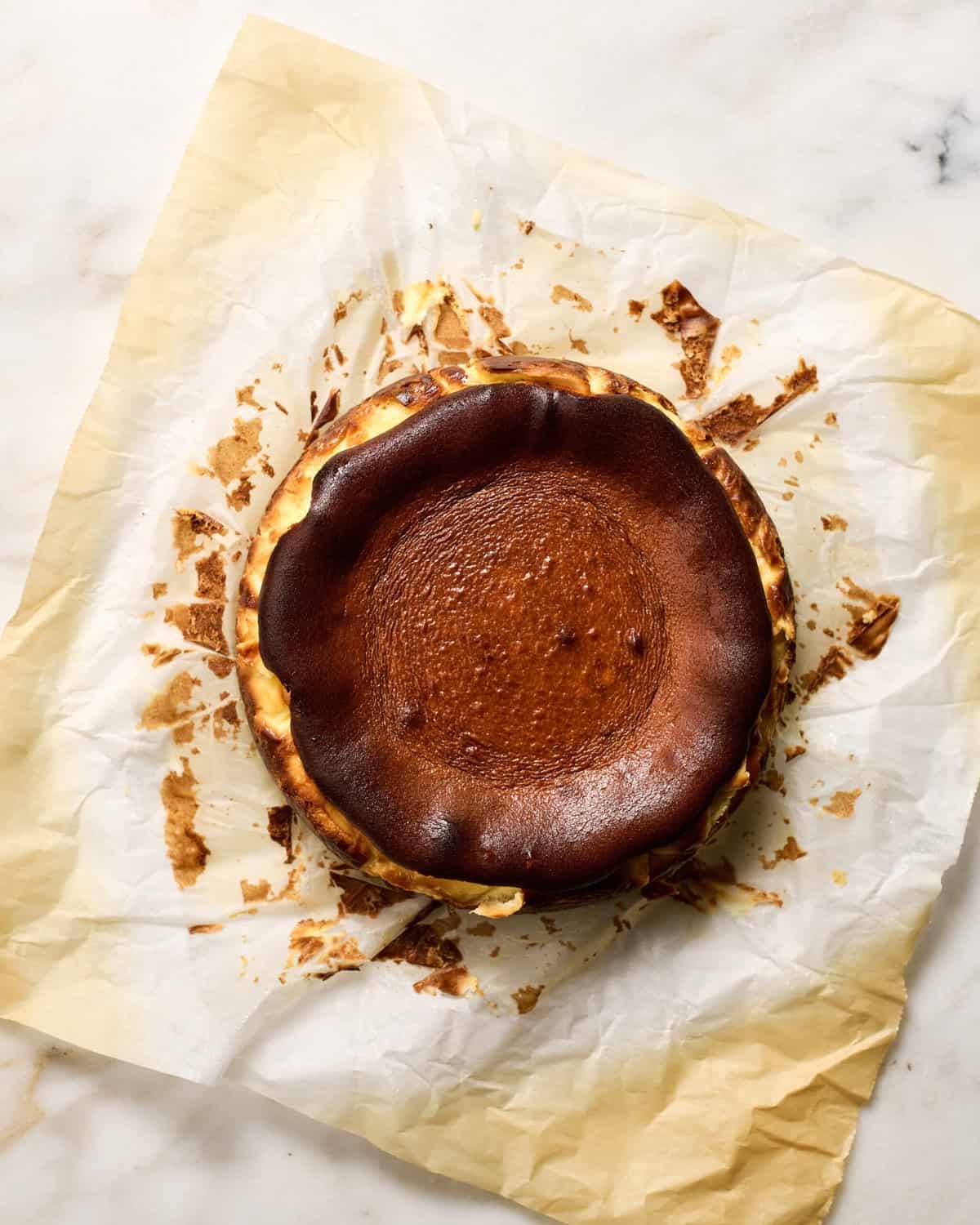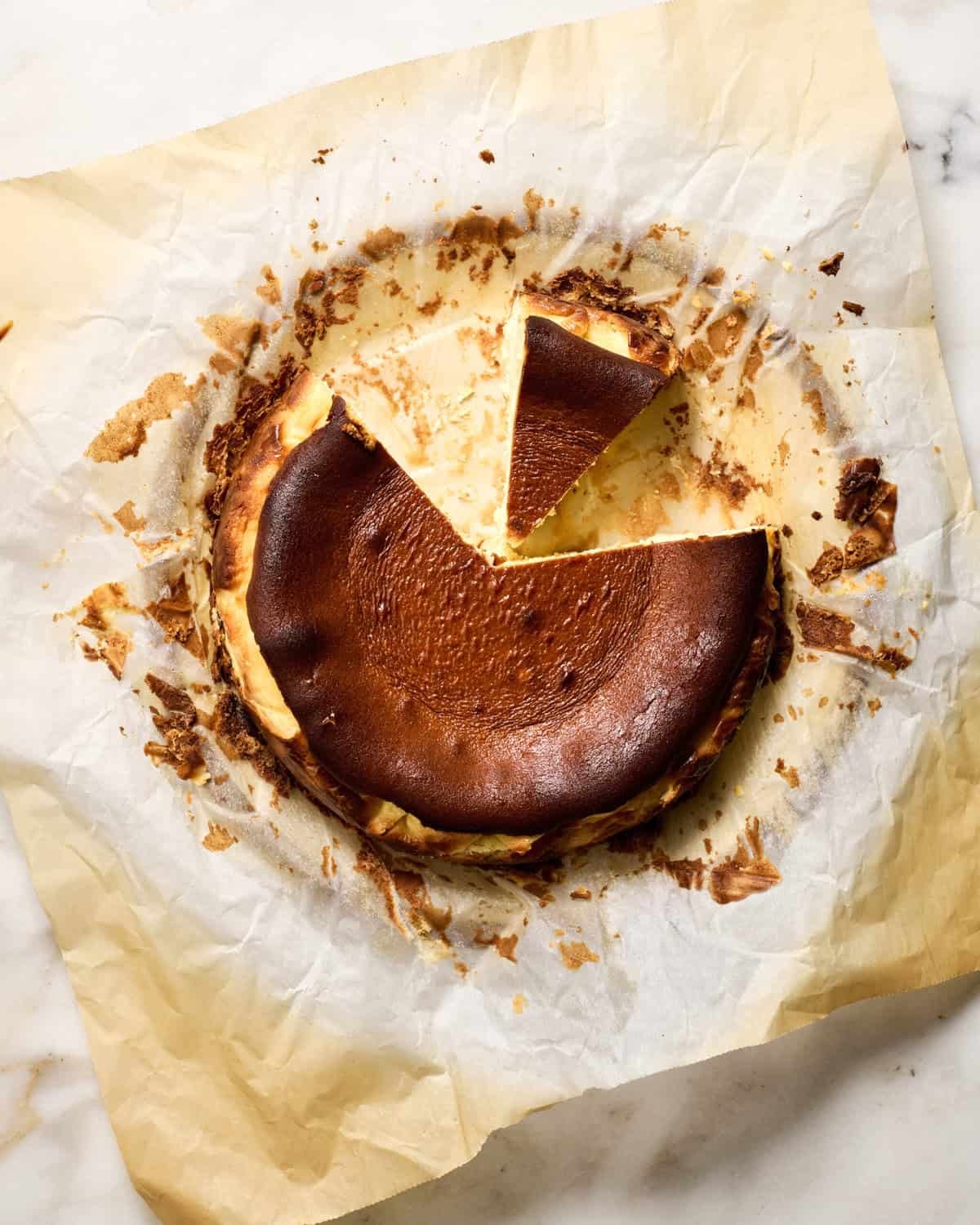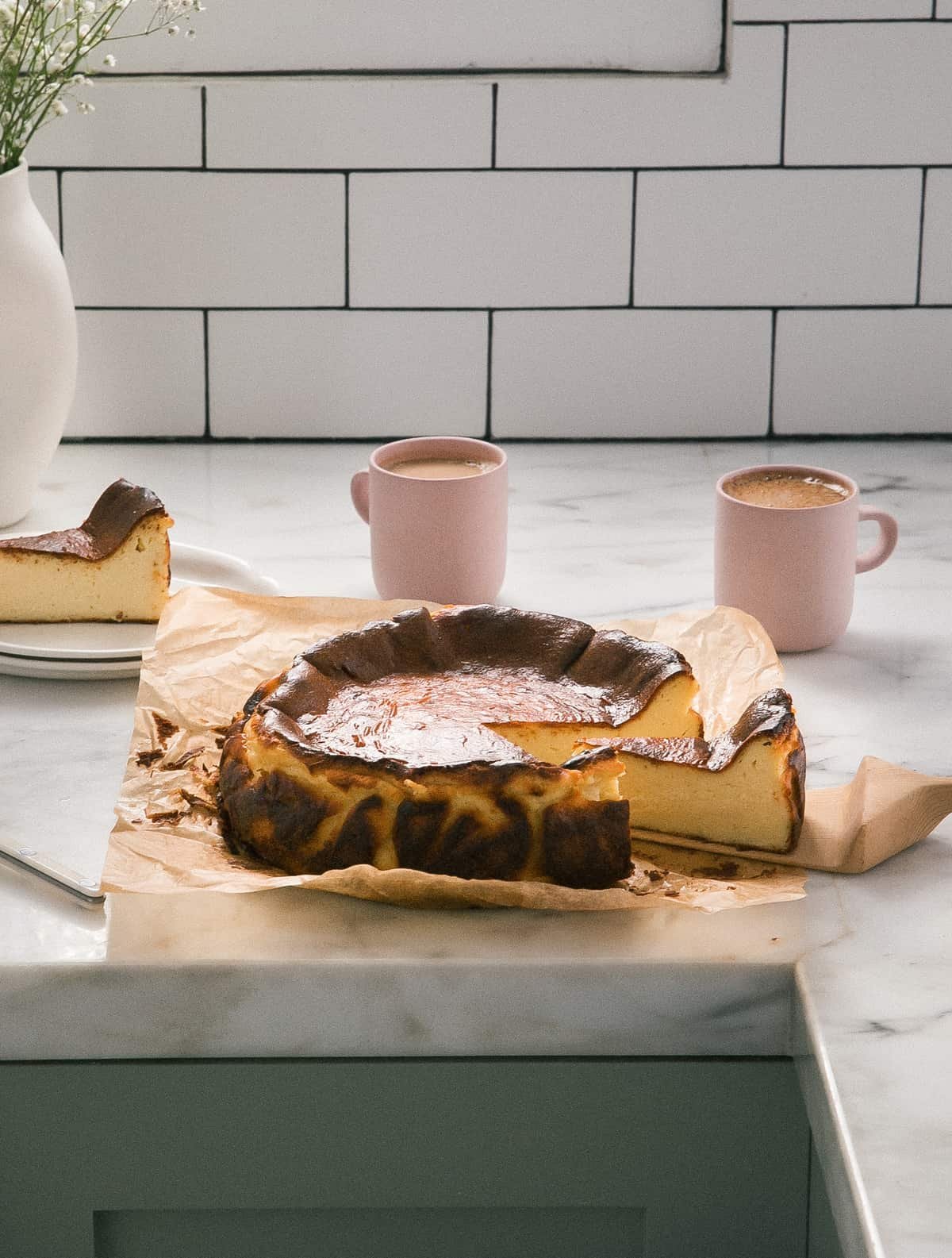Disclosure: This post may contain affiliated links, which means I can earn a commission if you click on the link and make a purchase.
This burned Basque cheese cake is shrouded in a caramelized crust with a creamy, rich interior. Basque cheese cake requires minimal ingredients, no special pan and zero water bath – easy! This cheese cake is from the Basque region of Spain and quickly becomes my go-to-dessert to make. Serve this Basque cheesecake for dessert with Spanish paella and Pan Con Tomate.

I lived far too long without having Basque cheese cake in my life. And I guess you have too! If you haven’t had it I’m glad to try to convince you to do this as soon as possible.
And while I love cheese cake (including but not limited to my marbled chocolate -cheesecake pumpkin, matcha swirl cheesecake and dulce de leche cheesecake bars), the Basque cheese cake is wildly different.
What is Basque cheese cake
Sorry for my ignorance, but when I first went to examine this cheese cake, I thought it would go back to the 1800s or something lol. But instead, I found that Basque Burnt Cheesecake first began to become popular in the 1990s in San Sebastian, Spain. A restaurant called La Viña invented this burnt topped silky smooth cheese cake that defies all cheese cake rules.
Ingredients you need for Basque cheese cake


- Cream cheese. This will be the base of this delicious cheese cake.
- Heavy cream. The heavy cream gives us really whipped and airy structure to this cheesecake.
- Flour for all purposes. This cheese cake has one very Minimal amount of flour. It’s just enough to keep it together.
- Egg. This adds wealth and the best structure to this cheesecake.
- Vanilla. I like to use a vanilla pod for this because it really shines in this type of application. But if you don’t have one, no worries, just use store -purchased or homemade vanilla extract.
For the rest of the ingredients, refer to the recipe indoor card below!
Basque cheese cake vs. Regular cheese cake
- First, there is zero crust, zero water bath. And it has its particularly burnt exterior that is 100% planned and intentional. I like to believe that its interior is more vanilla sauce -like versus a fluffy cream cream cheese type texture.
- This one is creamy but not too creamy. If you want it to be on an almost collapsed creaminess, you can add less flour (32 grams to be accurate).


Tips and tricks
- Cream cheese – Make sure you first beat the cream cheese; This helps to make sure it is completely smooth.
- Vanilla Substitution – If you don’t have a vanilla bean pod, just use 2 teaspoons of extract (I like to use homemade vanilla extract).
- Buttering of the pot! – The butter in the pan seems strange because we use parchment, but it helps with the parchment that adheres to the pan and does not move. Make sure the parchment paper goes up to the sides of the cake pan.
- Avoid it from cracking – A lot of cheese cakes will crack when they are swung from the oven to a shocking cooler temperature, ie. The room temperature in your kitchen. To avoid it from crackingI like to open the oven door a little towards the end of baking so it can gradually get to room temperature.
- How to tell if Basque cheesecake is done – You know when the timer goes off. It should twist in the middle. Don’t worry, it will set. You want it to be creamy in the middle.


Recipe frequently asked questions
It is light and airy with a delicious burnt, caramelized flavor.
While I love making homemade cream cheese for bagels and breakfast, I don’t recommend the homemade version for this cheese cake. You want a good quality store -bought cream cheese like Philadelphia’s (or something comparable). This is a sturdy cream cheese that gives this cheese cake structure.
Yes! Be sure to let it thaw completely in the refrigerator before serving.


More nice desserts
If you tried these Basque cheese cake Or any other recipe for my website please let a 🌟 Star classification And let me know how it went in 📝 Comments under. Thanks for the visit!
To prepare the pot:
-
Rub an 8-inch cake pan (or a spring mold pan) with approx. 1 teaspoon softened butter. This will help the parchment stick to it. Then press a sheet of parchment in the cake pan, press it up on the sides and make sure it is as close and secure on the pan as possible. Set aside.
To make the cheese cake:
-
Preheat the oven to 400 degrees F.
-
You can do this with an electric hand mixer or stand-up mixer. Add the cream cheese to the bowl and beat it until smooth. Pour in the granulated sugar and vanilla beans (or vanilla extract) and beat it until smooth and fluffy, about 1 minute. Next, crack in one egg at a time and mix it in before adding the following. Repeat until you have worked you through the eggs. Add salt and pour the heavy cream into a slow and steady current and mix until combined, approx. 1 minute. Finally, sift in the flour and mix it in until they are just incorporated.
-
Pour the cheesecake mixture into the prepared pan and smooth out of the top. Taste it on the counter a few times, so make sure it comes in these columns in the parchment paper.
-
Place the baking pan on a baking sheet (I do this if there is any waste – there should be no) and transfer to the oven to bake for 45 to 50 minutes until the cheese cake is breathed and jiggly.
-
Remove it from the oven and allow to cool in the pan for about 1 hour. Remove it from the pan by lifting up the excess parchment. Let it cool for 1 hour more.
-
When cooled, the cheese cake falls in size and firmly. Peel the parchment and slice it up. I like to serve this cheesecake by itself at room temperature.
Tips and tricks
- This recipe is super easy. But be sure to beat the cream cheese first. Just to ensure total smoothness.
- If you do not have a vanilla bean pod, just use 2 teaspoons of extract.
- The butter in the pan works strange because we use parchment, but it helps with the parchment that adheres to the pan and does not move.
- Make sure the parchment paper goes up to the sides of the cake pan.
Serving: 8g | Calories: 271Kcal | Carbohydrates: 30g | Protein: 1g | Fat: 17g | Saturated fat: 10g | Cholesterol: 61mg | Sodium: 163mg | Potassium: 39mg | Fiber: 1g | Sugar: 25g | Vitamin A: 656Iu | Vitamin C: 1mg | Calcium: 29mg | Iron: 1mg
Nutrition information is automatically calculated so that they should only be used as an approximation.
